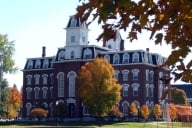You have /5 articles left.
Sign up for a free account or log in.
Could a medical school at Syracuse University be the ticket the institution needs to radically ascend the ranks of research universities? Or are its uncertain plans to fund the school and a crowded local market too much to overcome?
In his year and a half as chancellor, Kent Syverud has prioritized research programs in an effort to raise the university's stature among research universities and in the rankings.
Now Syracuse is exploring a medical school that would graduate doctors into the Veterans Administration Hospital pipeline -- a move that, if executed, would likely add significantly to the university's research grant total, reaching levels beyond where it was four years ago when it left the American Association of Universities in order to avoid being kicked out.
Syverud’s goals are seen by some on Syracuse’s campus as a tweaking of mission for the university, which in the past decade has tried a number of strategies with different definitions of excellence.
Syracuse’s previous chancellor, Nancy Cantor, who left in 2014 to lead Rutgers University at Newark, grew the Syracuse footprint in downtown Syracuse, expanded racial and socioeconomic diversity on campus, and largely ignored rankings. Cantor pushed the idea that professors' research should help the community and promote good teaching. Accessibility and social justice were at the forefront of her vision.
Yet in her efforts, Cantor was criticized for enrolling classes that were too large and not competitive enough. During Cantor’s tenure, some faculty and alumni complained when Syracuse fell from No. 52 to No. 62 in the U.S. News & World Report undergraduate rankings (the university is now ranked No. 58).
In contrast, Syverud has from the beginning been an advocate of Syracuse improving its academic reputation, measured in ways rankers value, and research enterprise.
“Chancellor Cantor’s emphasis was on scholarship and action … but it included a lot of elements of community outreach and a broader definition of research,” said Harriet Brown, a magazine journalism professor at Syracuse. “The board and the new chancellor have decisively turned away from that and definitely want to up our academic research.”
Brown has been at the university for eight years and says that now more than ever faculty are being encouraged to apply for research grants and are being given support in putting those grants together. “It’s definitely become a hot issue,” she said.
Added Patrick Mather, director of the Syracuse Biomaterials Institute, “We have this sort of anticipation and this excitement about going to the next level.”
Syracuse thus far has offered few details on the idea of creating a new medical school, which administrators say is still in the nascent stages of development. The cost, the funding and the exact location are all mysteries at this point.
What Syracuse would like to do is create a medical school that would partner with the Department of Veterans Affairs System -- which has some 1,700 hospitals and care facilities throughout the U.S. and which predicts a shortage of doctors in the near future.
Students would ideally receive their medical educations for free, and then be obligated to serve a certain number of years as a VA doctor. Presumably, the cost of providing medical educations for the 180 to 200 students at the school would be covered by federal, corporate and foundation funding -- although Syracuse officials don’t yet have funding partners for the project.
Syracuse officials have presented their ideas to VA administrators, but at this point the VA has not committed to a partnership. Yet Syracuse’s proposal very much relies on partnering with the agency.
Syracuse Provost Elizabeth Liddy said the project can’t go forward without some level of significant funding from the VA, and that no plans exist to pursue a medical school with a more traditional funding model.
At this point, the university is trying to solidify the idea enough to compete in a regional initiative started by Governor Andrew Cuomo aimed at making upstate New York more competitive. Some $500 million over five years is on the table to support a range of projects.
Syracuse administrators say their latest idea is in part a response to VA projections that there will soon be a shortage of doctors in the expansive medical system. They say a medical school could create as many as 1,500 jobs in the region. Yet a nearby medical school says the market in upstate New York is already crowded enough. And nearby doesn't mean in the region. It means across the street.
The president of the Upstate Medical University, a part of the State University of New York system, wrote to Syverud that a new medical school would likely harm his institution by overcrowding the local market. About 100 of the college’s 450 residency positions are with the VA, and most of the doctors at the local VA are on faculty at Upstate, which is also located in Syracuse.
In a letter to colleagues, Upstate’s interim president, Gregory Eastwood, emphasized what a large and expensive undertaking it is to open a new medical school.
“Operating a medical school is enormously expensive. It requires not only a lot of money, but also buildings, equipment, people, and relationships with hospitals and practitioners,” he wrote. Upstate’s medical school used to belong to Syracuse, which in the mid-1950s sold it to SUNY.
Yet administrators at the neighboring Crouse Hospital say their hospital actually has capacity for more residents, and are supportive of Syracuse exploring the idea of creating a new medical school.
Administrators at Syracuse say if their idea goes forward, their medical school would have a national focus and send residents to VA hospitals throughout the country. The impact on Upstate, they say, would be minimal.
“Our lens is not a local lens. Our lens is a national lens. The VA anticipates a doctor shortage of up to 22,000,” said J. Michael Haynie, Syracuse’s vice chancellor for veteran and military affairs. “So whether or not there is a shortage in the local area is in a lot of ways not relevant to the vision we have here.”
Administrators emphasize that they are still very much in the exploration phase. Syracuse is assembling a faculty committee to advise administrators on the project.
Syverud and Cantor denied requests for interviews for this article. The Veterans Administration did not respond to requests for information.
Samuel Gorovitz, a philosophy professor and former dean of Syracuse’s College of Arts and Sciences, says he’s waiting to pass judgment on the idea.
“No one should see this vague idea as a good or bad plan,” he said. “It would require much honest work to develop it into a plan one could assess as having pros and cons.”
Gorovitz, who has taught bioethics at Upstate, did say another medical school in the region would have a negative effect on Upstate, and to claim otherwise “is, on its face, not credible.”
Yet not everyone is reserving criticism.
“People who have been here a long time roll their eyes at this kind of thing because they’ve seen the pendulum swing,” said a Syracuse professor who asked not to be named. “There are fears about what the priorities of the board and the chancellor are … there’s been a huge amount of skepticism.”
The Change
Liddy, the provost, said Syracuse is focused not only on expanding its graduate research offerings, but also on making sure there are research opportunities for undergraduates as well. A recent planning process resulted in a strategic plan that is heavily focused on research, she said.
Some are wondering if an increased emphasis on research will mean less emphasis on teaching and diversity. Administrators at Syracuse say that’s not the case.
Students in 2014 staged a sit-in at Syracuse’s administration building that lasted more than a week. Their fear? That Syverud was backing off from Syracuse's commitment to diversity.
It’s still early to tell if Syracuse’s quest to become a more prestigious research university will affect its accessibility. In fall 2014, 25 percent of Syracuse’s students received Pell Grants, which are only available to low-income students, compared to 27 percent the year before.
“I’ve been at senate meetings where there was heated debate among the faculty and the administration about that tension [between] diversity in the student body and in the faculty body and rankings,” Brown said. “It makes me nervous for sure, and it definitely made the students nervous last year.”
Yet Brown said in the effort to increase its research and overall profile, Syracuse’s emphasis on veterans makes sense. The VA hospital in downtown Syracuse is near campus. And veterans, by virtue of their experience, bring a diverse set of views to the classroom, which is important to Brown, who is the chair of the diversity committee in Syracuse’s University Senate.
Haynie, the vice chancellor for veteran affairs, agrees.
Veterans are already the university's biggest area of research: more than half of Syracuse’s sponsored research dollars last year flowed through the institute, he said. In the five years since the institute began, its staff and affiliated faculty have grown from four people to 60.
In the years following World War II, Syracuse offered admission to all veterans, and enrolled some 10,000 students on the G.I. Bill. It has for decades operated programs for military personnel, including training for military comptrollers and photojournalists. Syracuse doesn’t require veterans using the G.I. Bill, which offers tuition assistance for veterans, to pay tuition beyond what the benefit covers.
“When Kent Syverud arrived as our chancellor, [one of his] goals was to elevate the importance, the impact, the quality of research that we do at this institution,” Haynie said, adding that another goal is be “the best” university when it comes to the academic study and support of veterans.
“There are lots of folks who are spun up in a silo about a medical school. But that’s not necessarily the right framing of this narrative,” he said. “We see an opportunity … to create a national hub of thought leadership, programming and policy analysis [for veterans].”
During her decade-long tenure, Cantor did make gains in research. She hired Mather as director of the Biomaterials Institute -- Mather recalls Cantor being enthusiastic about the social good his research could bring about -- and she began the Institute for Veterans and Military Families, which has in many ways set the stage for the veterans-centered approach of Syverud’s medical school proposal.
She’s also credited with hiring talented assistant professors who, over time, are expected to increase the university’s research performance.
Yet Cantor had a broad view of research that’s not shared by many in higher education -- she viewed much of Syracuse’s outreach with its home city as research. And she expressed clear displeasure when Syracuse was forced to leave the AAU, arguing that the prestigious organization focused too much on “a particular slice of science R&D” and federally funded research, but didn’t capture areas such as environmental sustainability, urban education and other work important to its city and region.
“At some point there was an aha moment about what our strengths are and that they would add up to this,” Mather said, adding that the ingredients for a research university were there before Syverud came to Syracuse, but he’s the one who attempted to put them together in an effort to amplify research at the university. “That’s what he brought to the table: a realization that to be a really good university you have to be strong at research.”
Mather hopes that one day Syracuse can rejoin the AAU.
A medical school would be an integral part of raising Syracuse’s profile and accomplishing that goal. The vast majority of institutions in the AAU have medical schools that drive a large chunk of their research.
“If you do not have a medical school, it’s hard to compete,” Liddy said.








